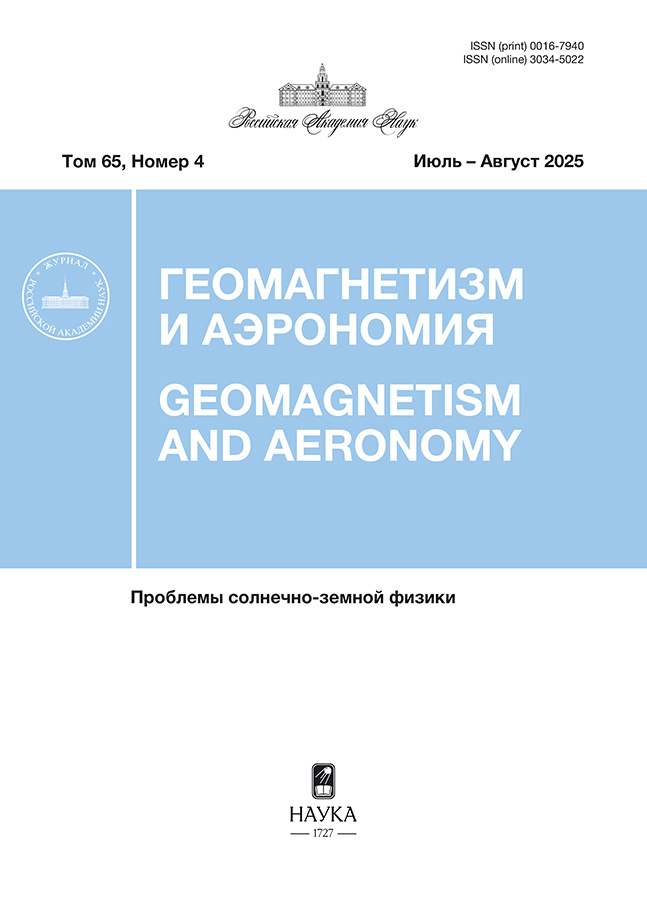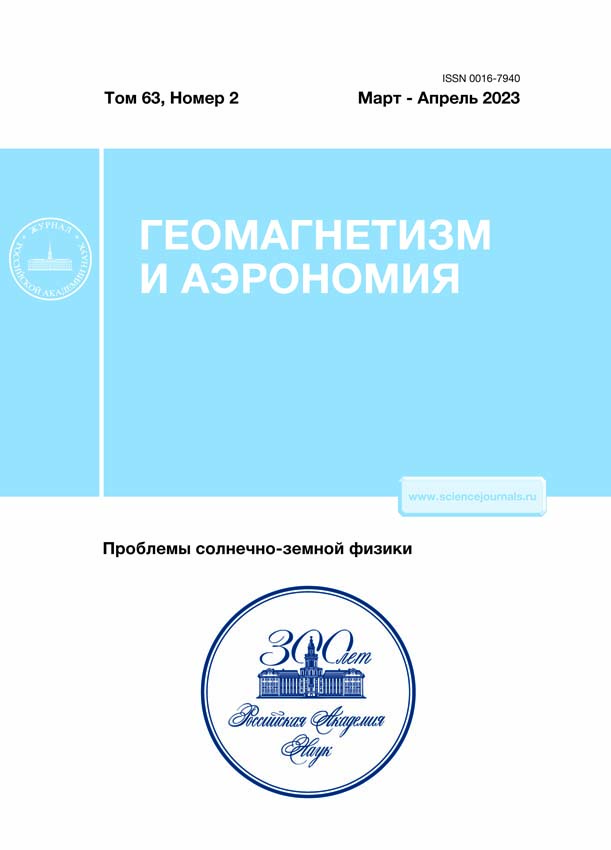Equatorial Plasma Bubble Occurrence Probability with Respect to Month of Year
- Authors: Sidorova L.N.1
-
Affiliations:
- Pushkov Institute of Terrestrial Magnetism, Ionosphere, and Radiowave Propagation (IZMIRAN), Russian Academy of Sciences
- Issue: Vol 63, No 2 (2023)
- Pages: 238-246
- Section: Articles
- URL: https://ruspoj.com/0016-7940/article/view/651030
- DOI: https://doi.org/10.31857/S0016794022600533
- EDN: https://elibrary.ru/DLENDL
- ID: 651030
Cite item
Abstract
In this paper, the variations of the equatorial plasma bubble occurrence probability with respect
to month of year are investigated. For this purpose, the data obtained on board the ISS-b satellite (~972–
1220 km) in the mid−latitude region ±(25°–55°) DIPLAT of the both hemispheres for a year and a half of
the observations (August 1978–December 1979) were used. The comparative analysis of the studied characteristic
with the monthly variations of the meridional wind velocity was carried out. For this purpose, the
wind velocity data calculated from the Horizontal Wind Model (HWM14) were used. 1. It was revealed that
the maximal plasma bubble occurrence probability values take place each time during the local winter: December–
February in the Northern Hemisphere (~19%) and June–August in the Southern Hemisphere (~29%).
The minimal values take place in the local summer: June–August in the Northern Hemisphere (~3%) and
December–February in the Southern Hemisphere (~4%). As a result, there is asymmetric plasma bubble
development relative to the geomagnetic equator during the solstices. 2. It was revealed that the relative
equality of the plasma bubble occurrence probability values takes place in the histograms of the different
hemispheres during the equinoxes. As a result, there is almost symmetrical plasma bubble spreading relative
to the geomagnetic equator during these periods. 3. It was revealed that the maximal plasma bubble
occurrence probability values take place in each hemisphere during the local winter, when the meridional
winds developing there favors the downward bubble plasma and, accordingly, the bubble spreading along
the flux tube. The minimal plasma bubble occurrence probability values take place in each uplift hemisphere
during the local summer season, when the meridional wind favors the bubble plasma and slows the
bubble spreading.
About the authors
L. N. Sidorova
Pushkov Institute of Terrestrial Magnetism, Ionosphere, and Radiowave Propagation (IZMIRAN),Russian Academy of Sciences
Author for correspondence.
Email: lsid@izmiran.ru
Moscow, Troitsk, 108840 Russia
References
- − Брюнелли Б.Е., Намгаладзе А.А. Физика ионосферы. М.: Наука. 499 с. 1998.
- − Сидорова Л.Н., Филиппов С.В. Долготная статистика плазменных “пузырей”, видимых на высотах верхней ионосферы в концентрации Не+ // Геомагнетизм и аэрономия. Т. 53. № 1. С. 64–77. 2013.
- − Сидорова Л.Н., Филиппов С.В. Регистрация плазменных “пузырей” на высотах верхней ионосферы: численные оценки // Геомагнетизм и аэрономия. Т. 54. № 3. С. 355–364. 2014.
- − Сидорова Л.Н. Экваториальные плазменные “пузыри”: Изменчивость широтного распределения с высотой // Геомагнетизм и аэрономия. Т. 61. № 4. С. 445–456. 2021. https://doi.org/10.31857/S0016794021040167
- − Сидорова Л.Н. Экваториальные плазменные пузыри: Влияние термосферных меридиональных ветров // Геомагнетизм и аэрономия. Т. 62. № 3. С. 374–382. 2022. https://doi.org/10.31857/S0016794022030166
- − Abdu M.A. Outstanding problems in the equatorial ionosphere-thermosphere electrodynamics relevant to spread F // J. Atmos. Terr. Phys. V. 63. № 9. P. 869–884. 2001.
- − Barros D., Takahashi H., Wrasse C.M. et al. Asymmetric development of equatorial plasma bubbles observed at geomagnetically conjugate points over the Brazilian sector // J. Geophys. Res. V. 127. № 6. e2021JA030250. 2022. https://doi.org/10.1029/2021JA030250
- − Comberiate J., Paxton L.J. Coordinated UV imaging of equatorial plasma bubbles using TIMED/GUVI and DMSP/ SSUSI // Space Weather. V. 8. S10002. 2010. https://doi.org/10.1029/2009SW000546
- − Devasia C.V., Jyoti N., Subbaro K. S. V. et al. On the plausible leakage of thermospheric meridional winds with equatorial spread F // J. Atmos. Sol. Terr. Phy. V. 64. № 1. 2002.
- − Drob D.P., Emmert J.T., Meriwether J.W. et al. An Update to the Horizontal Wind Model (HWM): The Quiet Time Thermosphere // Earth and Space Science. V. 2. № 7. P. 301–319. 2015. https://doi.org/10.1002/2014EA000089
- − Gasperini F., Forbes J.M., Doornbos E.N. et al. Synthetic thermosphere winds based on CHAMP neutral and plasma density measurements // J. Geophys. Res. V. 121. № 4. P. 3699–3721. 2016. https://doi.org/10.1002/2016JA022392
- − Huang C.S., Kelley M.C. Nonlinear evolution of equatorial spread F: 3. Plasma bubbles generated by structured electric fields // J. Geophys. Res. V. 101. P. 303–313. 1996.
- − Huba J.D., Krall J. Impact of meridional winds on equatorial spread F: Revisited // Geophys. Res. Lett. V. 40. P. 1268–1272. 2013. https://doi.org/10.1002/grl.50292
- − Jyoti N., Devasia C. V., Sridharan R. et al. Threshold height (h’F)c for the meridional wind to play a deterministic role in the bottom side equatorial spread F and its dependence on solar activity // Geophys. Res. Lett. V. 31. L12809. 2004. https://doi.org/10.1029/2004GL019455
- − Kelley M.C. Ionosphere / Encyclopedia of Atmospheric Science. Eds. James R. Holton, John A. Pyle and Judith A. Curry. London: Academic Press, Elsevier Science. 1022 p. 2002.
- − Kil H., Paxton L.J., Oh S.-J. Global bubble distribution seen from ROCSAT-1 and its association with the pre-reversal enhancement // J. Geophys. Res. V. 114. № A06307. 2009. https://doi.org/10.1029/2008JA013672
- − Krall J., Huba J.D., Joyce G. et al. Three-dimensional simulation of equatorial spread-f with meridional wind effects // Ann. Geophysicae. V. 27. № 5. P. 1821–1830. 2009.
- − Krall J., Huba J.D., Joyce G. et al. Simulation of the seeding of equatorial spread-f by circular gravity waves // Geophys. Res. Lett. V. 40. P. 1–5. 2013.
- − Maruyama T. A diagnostic model for equatorial spread F. 1. Model description and application to electric field and neutral wind effects // J. Geophys. Res. V. 93. P. 14.611–14.622. 1988.
- − Maruyama T., Saito S., Kawamura M. et al. Equinoctial asymmetry of a low-latitude ionosphere-thermosphere system and equatorial irregularities: evidence for meridional wind control // Ann. Geophysicae. V. 27. P. 2027–2034. 2009. https://doi.org/10.5194/angeo-27-2027-2009
- − Mendillo M., Meriwether J., Biondi M. Testing the thermospheric neutral wind suppression mechanism for day-to-day variability of equatorial spread F // J. Geophys. Res. V. 106. № A3. P. 3655–3663. 2001.
- − Otsuka Y., Shiokawa K., Ogawa T. et al. Geomagnetic conjugate observations of equatorial airglow depletions // Geophys. Res. Lett. V. 29. № 15. P. 43-1–43-4. 2002. https://doi.org/10.1029/2002GL015347
- − Rodriguez–Zuluaga J., Stolle C. Interhemispheric field-aligned currents at the edges of equatorial plasma depletions // SCI REP V. 9. № 1. P. 1–8. 2019.
- − RRL. Summary Plots of Ionospheric Parameters obtained from Ionosphere Sounding Satellite-b. Tokyo: Radio Research Laboratories Ministry of Posts and Telecommunications. V. 1–3. 1983.
- − RRL. Summary Plots of Ionospheric Parameters obtained from Ionosphere Sounding Satellite-b. Tokyo: Radio Research Laboratories Ministry of Posts and Telecommunications. Special Report. V. 4. 1985.
- − Sau S., Narayanan V., Gurubaran S. et al. First observation of interhemispheric asymmetry in the EPBs during the St. Patrick’s Day geomagnetic storm of 2015 // J. Geophys. Res.–Space. V. 122. № 6. P. 6679–6688. 2017.
- − Sobral J., Abdu M., Pedersen T. et al. Ionospheric zonal velocities at conjugate points over Brazil during the COPEX campaign: Experimental observations and theoretical validations // J. Geophys. Res. V. 114. № A04309. P. 1–24. 2009. https://doi.org/10.1029/2008JA013896
- − Sidorova L.N., Filippov S.V. Topside ionosphere He+ density depletions: seasonal/longitudinal occurrence probability // J. Atmos. Sol. Terr. Phy. V. 86. P. 83–91. 2012. https://doi.org/10.1016/j.jastp.2012.06.013
- − Sidorova L.N., Filippov S.V. Plasma bubbles in the topside ionosphere: estimations of the survival possibilities // J. Atmos. Sol. Terr. Phy. V. 119. P. 35–41. 2014. https://doi.org/10.1016/j.jastp.2014.06.013
- − Su S.-Y., Liu C.H., Ho H.H. et al. Distribution characteristics of topside ionospheric density irregularities: Equatorial versus midlatitude regions // J. Geophys. Res. V. 111. № A06305. 2006. https://doi.org/10.1029/2005JA011330
- − Tsunoda R.T., Livingston R.C., McClure J.P. et al. Equatorial plasma bubbles: vertical elongated wedges from the bottomside F layer // J. Geophys. Res. V. 87. P. 9171–9180. 1982.













